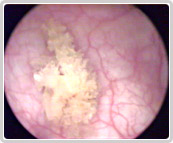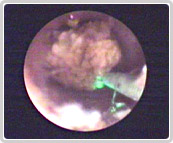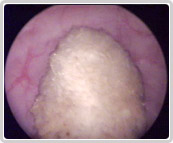|
|
  |
Renal Calculi |
|
 |
What is the Function of Kidneys?
|
| |
Kidneys are paired bean shaped organs located under the rib cage, on either side of the spine. They perform the function of removing excess water & toxins from the body. Every day about 2 litres of urine is formed by process of filtering & concentrating. This urine then flows down to the urinary bladder through 2 slender tubes called the ureters. Bladder is really like a storage tank, which stores the urine & empties it at our will. The kidneys also help in maintaining the blood pressure & in regulating Haemoglobin production. The also take major part in regulating calcium levels in the body.
|
 |
What is the Cause of Kidney Stones?
|
| |
The urine is thus a mix of waste water, salts, toxins, & other substances. If the balance between the salts & water in the urine is disturbed, the salts can from into crystals, which eventually become a stone. These stones may remain in the kidney or may get washed down the ureter, into the bladder & finally out of the body. Majority of the small stones get washed out without producing much pain. Larger stones may get lodged in the kidney or may get stuck in the ureter, producing severe pain. Sometimes the stones can lodge in the bladder, & may be responsible for pain, bleeding or infection.
|
| |
Inadequate water intake is the commonest cause of kidney stone formation. In addition, excess dietary intake of certain foods such as red meat, dairy products, very high protein diet & rarely excess of certain vegetables may contribute to stone formation. Some types of stones [uric acid, cystein] may be hereditary. Also people born with certain anatomical defects in the urinary tract may be more prone to developing stones.
|
| |
India being a tropical country has one of the highest incidences of stone disease in the world. In general, men are more commonly affected than women. Children with certain defects in the urinary system since birth or with mal nutrition, can get kidney stones.
|
 |
 |
|
Bladder Tumour |
|
What are these Stones Made of?
If you suffer from any of the above mentioned symptoms, it is best to contact your family doctor who may then refer you to a specialist. After examining you clinically, the doctor usually suggests examination of urine, sonography of the urinary tract & some simple blood tests. These usually give the diagnosis. Thereafter in some patients, especially when any surgical treatment is planned or kidney function is to be studied, a special test called I V U or intravenous urography is done. Here a special dye is injected intravenously, which makes the kidneys visible on the X ray. Here the kidney function, internal arrangement, exact location of the stone etc can be found out. Also the correct treatment can be planned. Patients forming stones repeatedly may need special blood tests to check the level of calcium, phosphate & uric acid. Sometimes 24 hour urine is checked for abnormal levels of these salts in urine.
|
 |
How are Urinary Stones Treated?
|
| |
During an acute attack of pain, some patients may need hospitalization & painkiller injections. Sometimes emergency endoscopic surgery is required to insert an internal tube (J J stent) in the kidney to bypass the obstruction by the stone.
|
| |
 |
Kidney Stones - Most of the stones in the kidney can be treated by either ESWL (Extra Corporeal Shockwave Lithotripsy) or PCNL (Per cutaneous nephrolithotomy). In ESWL, external shock waves are focused on the stone with the help of X ray or sonography & over a period of 2-5 sittings the stones are powdered. These then get washed down the ureter. This treatment usually does not need hospitalization or anaesthesia. In PCNL, a small telescope is inserted from the back into the kidney under anesthesia, the stone is visualized & then broken down using some form of energy source.(Such as laser). This treatment is minimally invasive & needs hospitalization for 3 to 5 days. Some kidney stones (2-5%) still need conventional open surgery.
|
 |
 |
|
Laser Lithotripsy |
|
Ureteroscopy - Majority of stones in the ureter get washed out simply by drinking a lot of water. Those which need treatment, more than 90% can be treated using endoscopic treatment with a special telescope called a ureteroscope. This can be passed from the external urethral opening, into the ureter & if required, even up to the kidney. The stones are visualized through this telescope & broken down using laser or other energy source. Often after this procedure, an internal J J stent is kept in the kidney. This tube is removed after 2-3 weeks, again endoscopically. Rarely, even today, ureteric stones may need open surgery.
|
 |
 |
|
Bladder Stone |
|
Stones in the Bladder - As above, more than 90% of bladder stones are treated endoscopically. Very large stones may still need open surgery. In elderly male patients, prostate gland obstruction may be the cause of such stones. In that case, prostate gland may need surgical treatment which can be done at the time of stone surgery. |
|
|
|
|
|
|
|